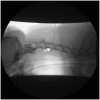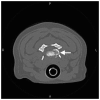Perineural Injection for Treatment of Root-Signature Signs Associated with Lateralized Disk Material in Five Dogs (2009-2013)
- PMID: 26858952
- PMCID: PMC4728328
- DOI: 10.3389/fvets.2016.00001
Perineural Injection for Treatment of Root-Signature Signs Associated with Lateralized Disk Material in Five Dogs (2009-2013)
Abstract
Intervertebral disk disease (IVDD) is common in dogs; cervical IVDD accounts for 13-25% of all cases. Ventral slot decompression provides access to ventral and centrally extruded or protruded disk material. However, procedures to remove dorsally or laterally displaced material are more difficult. This case series describes the use of perineural injection as a potential treatment option for dogs experiencing root-signature signs associated with lateralized disk material in the cervical spine. Five dogs underwent fluoroscopically guided perineural injection of methylprednisolone ± bupivacaine. Most patients experienced improvement in root-signature signs and remained pain free without the assistance of oral pain medication. These findings suggest the perineural injection of methylprednisolone ± bupivacaine represents a viable option for dogs with cervical lateralized disk material causing root-signature signs.
Keywords: fluoroscopy; intervertebral disk disease; lateralized disk; perineural; root-signature.
Figures



Similar articles
-
Ultrasound-guided paravertebral perineural glucocorticoid injection for signs of refractory cervical pain associated with foraminal intervertebral disk protrusion in four dogs.J Am Vet Med Assoc. 2021 May 1;258(9):999-1006. doi: 10.2460/javma.258.9.999. J Am Vet Med Assoc. 2021. PMID: 33856871
-
Characteristics of dogs admitted for treatment of cervical intervertebral disk disease: 105 cases (1972-1982).J Am Vet Med Assoc. 1992 Jun 15;200(12):2009-11. J Am Vet Med Assoc. 1992. PMID: 1639716
-
Evaluation of the association between spondylosis deformans and clinical signs of intervertebral disk disease in dogs: 172 cases (1999-2000).J Am Vet Med Assoc. 2006 Jan 1;228(1):96-100. doi: 10.2460/javma.228.1.96. J Am Vet Med Assoc. 2006. PMID: 16426177
-
Spontaneous regression of lumbar Hansen type 1 disk extrusion detected with magnetic resonance imaging in a dog.J Am Vet Med Assoc. 2014 Mar 15;244(6):715-8. doi: 10.2460/javma.244.6.715. J Am Vet Med Assoc. 2014. PMID: 24568114 Review.
-
A Review of Fibrocartilaginous Embolic Myelopathy and Different Types of Peracute Non-Compressive Intervertebral Disk Extrusions in Dogs and Cats.Front Vet Sci. 2015 Aug 18;2:24. doi: 10.3389/fvets.2015.00024. eCollection 2015. Front Vet Sci. 2015. PMID: 26664953 Free PMC article. Review.
Cited by
-
Ultrasonography-Guided Perineural Injection of the Ramus ventralis of the 7 and 8th Cervical Nerves in Horses: A Cadaveric Descriptive Pilot Study.Front Vet Sci. 2020 Feb 25;7:102. doi: 10.3389/fvets.2020.00102. eCollection 2020. Front Vet Sci. 2020. PMID: 32158773 Free PMC article.
-
Case series: Cervical far-lateral and combined cervical far lateral/foraminal intervertebral disk extrusions in 10 dogs.Front Vet Sci. 2024 Nov 6;11:1465182. doi: 10.3389/fvets.2024.1465182. eCollection 2024. Front Vet Sci. 2024. PMID: 39606656 Free PMC article.
-
Use of a Truffle Dog Provides Insight Into the Ecology and Abundant Occurrence of Genea (Pyronemataceae) in Western Oregon, USA.Ecol Evol. 2024 Nov 17;14(11):e70590. doi: 10.1002/ece3.70590. eCollection 2024 Nov. Ecol Evol. 2024. PMID: 39559470 Free PMC article.
-
Surgical management of a lumbar far lateral intervertebral disc extrusion in a cat.JFMS Open Rep. 2024 Aug 2;10(2):20551169241261577. doi: 10.1177/20551169241261577. eCollection 2024 Jul-Dec. JFMS Open Rep. 2024. PMID: 39099733 Free PMC article.
-
Evaluation of Cervical Myoclonus in Dogs with Spinal Diseases: 113 Cases (2014-2023).Animals (Basel). 2025 Aug 6;15(15):2298. doi: 10.3390/ani15152298. Animals (Basel). 2025. PMID: 40805088 Free PMC article.
References
-
- Bagley RS, Tucker R, Harrington ML. Lateral and foraminal disk extrusion in dogs. Comp Cont Educ Pract Vet (1996) 18(7):795–804.
-
- Smith BA, Hosgood G, Kerwin SC. Ventral slot decompression for cervical intervertebral disc disease in 112 dogs. Austr Vet Pract (1997) 27(2):58–64.
-
- Fry TR, Johnson AL, Hungerford L. Surgical treatment of cervical disc herniation in ambulatory dogs, ventral decompression vs fenestration, 111 cases (1980-1988). Prog Vet Neurol (1991) 2:165–73.
-
- Seim HB, III, Prata RG. Ventral decompression for the treatment of cervical disk disease in the dog: a review of 54 cases. J Am Anim Hosp Assoc (1982) 18:233–40.
Publication types
LinkOut - more resources
Full Text Sources
Other Literature Sources

